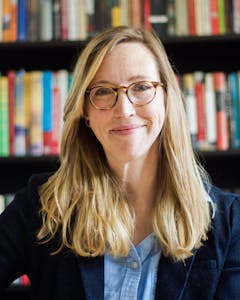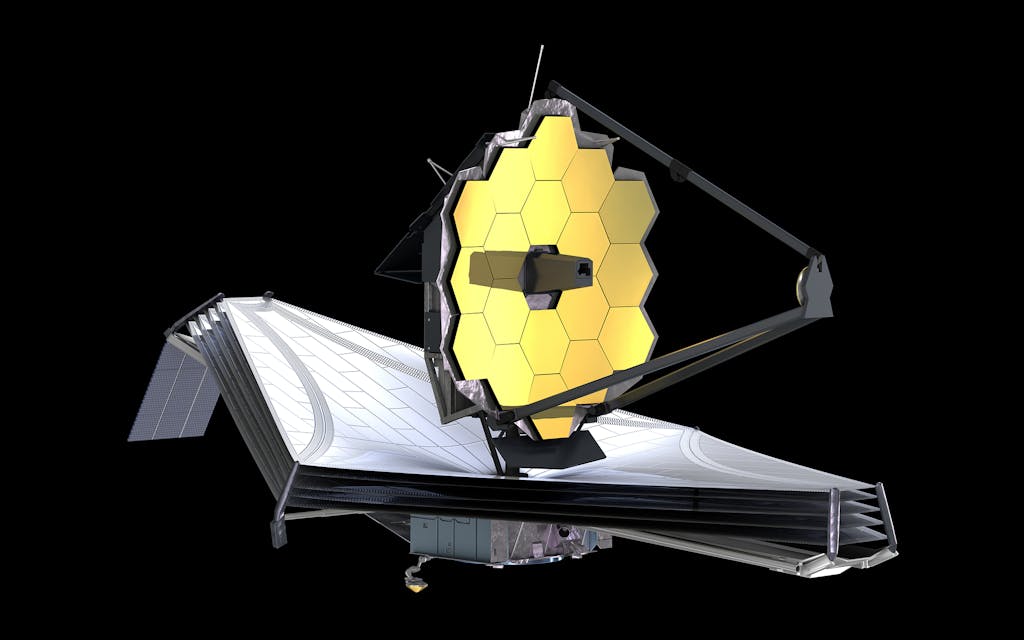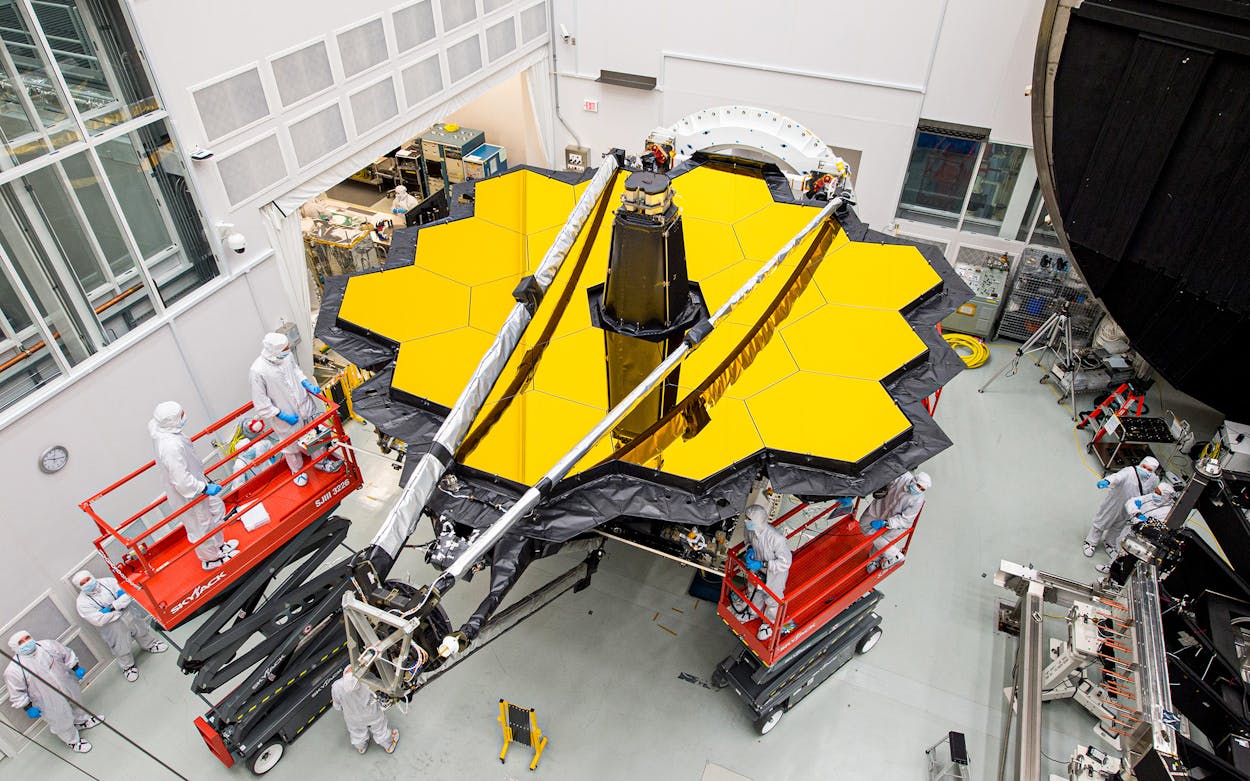This past March, UT-Austin astronomer Dr. Caitlin Casey was in the sleepless haze of early motherhood, holding a two-month-old baby on her lap, when she received an email akin to winning the scientific lottery. “Cycle One JWST Notification Letter,” was the subject line. Opening it, she read, “We are pleased to inform you that your James Webb Space Telescope Cycle one proposal title Cosmos Webb has been approved . . .”
She didn’t need to read further. Approved! She knew what this meant. She slammed her laptop shut and messaged her colleague Jeyhan Kartaltepe, an astrophysicist at the Rochester Institute of Technology. “We got it—oh my God, we got it,” Casey typed.
“No!” Kartaltepe responded, dumbfounded.
What Casey got was the largest project on the new, long-awaited James Webb Space Telescope, which is scheduled to launch from French Guiana on December 18. The world’s most powerful telescope, the Webb is expected to transform the way we understand the universe. Naturally, astronomers from around the world, hoping for precious research hours, sent proposals to the Space Telescope Science Institute (STScI). In its March email, the center granted Casey and her team more time than any other group.

At 36 years old, only eleven years after getting her PhD, Casey is relatively young to be awarded such a distinction. But she had other reasons to be surprised. Her proposal, the COSMOS-Webb—which she and Kartaltepe wrote together over the pandemic, in Zoom conversations with dozens of colleagues who would work on the project with them across the globe—was almost absurdly ambitious. Whereas the conventional wisdom with the Webb telescope was to look deeply at a tiny portion of sky the size of a pinpoint held at arm’s length, Casey and Kartaltepe asked to see a patch considerably larger, the size of three full moons on an average night. The STScI granted them 218 hours, or roughly eight days, of telescope time. (“Most programs are in the six-hour range,” she says.) If all goes well, the resulting images and data will step right up to the doorstep of the Big Bang, nearly 14 billion years ago, to show the magical but mysterious period when a dark, soupy mess of atoms were ionized by the first sources of light.
I met Casey this past October in her small office, on the sixteenth floor of UT’s towering Physics, Math, and Astronomy Building, where a giant dry-erase board that covered nearly half a wall was filled with equations. She is quick to teach, easily drawing analogies that a layperson can understand, and she exudes an excitement that even several cups of coffee could not manufacture, laughing readily as if she’s sharing thrilling gossip while saying things like, “We get to think about the beginning of time itself, right?”
When Casey first focused on the obscure early universe for her PhD, which she earned at the University of Cambridge in 2010, most of what we knew was shaped by the NASA Hubble Space Telescope—the groundbreaking equipment that primarily measured starlight. Using the Hubble, astronomers could see starlight clear across the observable universe, including images dating almost as far back as the Big Bang. But not quite far enough to see those earliest years. (One of the more mind-blowing things about powerful telescopes is that they allow for a kind of time travel: since light from far away takes many years to reach Earth, and the universe is expanding, the Webb will show us images from the universe’s history as it probes deeper and deeper into space.) “We think we have a pretty good idea of how things went in the past ten, eleven billion years,” Casey says. “But it’s those first few billion years where you start to get really interesting questions that challenge our idea of how physics works. A lot of the big-picture questions are a little bit like a chicken-and-egg problem.”
Cosmically, the chicken-and-egg problem goes like this: We know that stars are born from gas, and that gas condenses after stars die, starting the cycle over. But how, scientists want to know, did that process begin? The Hubble provided images of a few early galaxies—the oldest being 400 million years after the Big Bang—giving astronomers a glimpse into what that era might have looked like. Still, the sample was too small to reach definitive conclusions. To further explore that period, astronomers needed a telescope that was primarily operational at infrared wavelengths, as the light from the distant galaxies is stretched on its journey to us, or “red-shifted,” into infrared.
Enter the revolutionary James Webb Space Telescope. Casey was about eleven years old in 1996, when scientists formally recommended an infrared telescope as NASA’s next major project. Over the ensuing decades, a team of more than 1,200 scientists and engineers from fourteen countries has been pushing the limits of technology to create it. Operating at a frigid negative 370 degrees Fahrenheit, so that its infrared sensors can function, the $9.7 billion observatory will set itself up in space after launch, unfurling its eighteen hexagonal mirrors coated in gold one million miles from Earth. It has to work perfectly; if anything goes wrong, the telescope will be too far away for repair. “We’re all very nervous about that,” Casey says, noting that the telescope’s sunshield layers, which block the sun’s interfering light and heat, are as thin as single human hairs. “Oh gosh, it’s so scary to me. Yeah, I’m glad I don’t work on that or have to think about that.”

Casey, like all astronomers, has been anticipating the Webb’s arrival for years. The Webb will multiply by orders of magnitude the number of galaxies we can see from the earliest eras of the universe. It will also provide clearer data on some of the biggest astronomical questions, such as those concerning star life cycles, galaxy behavior over time, planets outside our solar system, and evidence of life beyond Earth. Using the telescope as it was intended, most of the research will focus on tiny spots and go as deep as possible. (This is the case with Casey’s UT colleague Steven Finkelstein, who will be studying the early epoch of light for around one hundred hours for the Webb Deep Extragalactic Exploratory Public [WDEEP] Survey.)
But Casey’s unconventional proposal sold the idea that instead of going narrowly into a deep field, it was important to have more context and survey a wide area, patching together a mosaic. Describing the structure of the universe as spongelike, she explains that some areas are like pockets, or empty voids with no galaxies, while other areas are like knots that have thousands of densely packed galaxies. Without a wider perspective, a single point in space could lead to the wrong conclusions. “You might think that, ‘Well, oh, you know, galaxies just don’t exist at that time in the universe’s history,’ ” she says. “But you could have landed on a void.”
While the bulk of her observations aren’t scheduled to take place until April of 2023, Casey’s preparations are well underway. She’ll be gathering data from observatories around the world to prepare for when she receives the long-awaited images and data. What she predicts she’ll find, when this survey is taken over eight critical days, is about a million galaxies—four to five thousand of which formed in the epoch of reionization. Several hundred million years after the Big Bang, when the universe was mostly composed of neutral hydrogen, cooling and expanding, gas clouds began to collapse under their own gravity and form stars that slowly but surely turned a very foggy place into a clearer one where light traveled freely. “We can use that data to refine our models of how we think the universe actually formed,” Casey says. “Yeah. It’s a big deal.”
- More About:
- Austin








